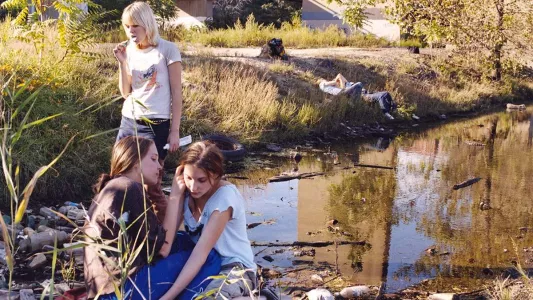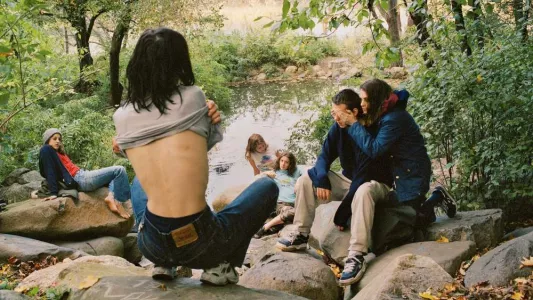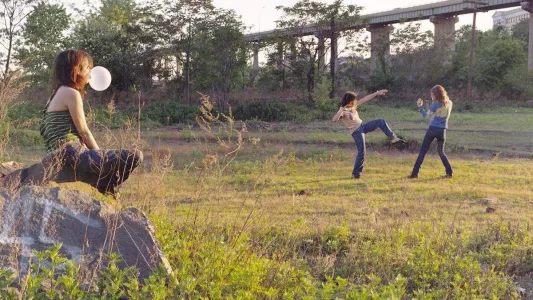The fine-art photographer and untiring traveller Justine Kurland, is well-known for her extensive and itinerant work of an idealized on the road pastoral of North America.
Born in 1969 in Warsaw, NY, she graduated from the NY School of Visual Arts in 1996. Right after completing her studies - and having just enrolled in a Master of Fine Arts program at Yale University - she decided to explore the United States wilderness. For twenty years, she documented her many cross-country road trips through images which depict the pristine but also adulterated side of American landscapes.
Kurland’s ambivalent vision of rural America shows how dystopia and utopia are deeply intertwined in a narrative continuum : from a stop sign standing in a roadside in the middle of nowhere to the idyllic, vast expanse of the Arcadian meadows.
The upcoming book Girl Pictures, written by Rebecca Bengal and published by Aperture, illustrates Kurland’s first body of work, with a selection of sixty-nine vintage color prints celebrating girlhood and femininity.
Departing from New Haven’s hinterland and heading towards more open wild spaces, Kurland recruted her models on the way and asked them to travel with her in an old green van moving from New York to Connecticut until intermontane West California and the American South. Even though Kurland’s images are accurately staged and constructed, they expressed a profoundly intimate and genuine quality.
Kurland’s photographs completely reverse the patriarchal cliché of United States civilization and mythology that has always been extremely male-oriented. Starting from Far West imagery to prominent figures of the Beat Generation movement, men repeatedly dominate the scene. In Kurland’s landmark work, teenage girls become the only symbol of escape and freedom, celebrated as unique, rebel-at-heart heroines in a frontier Eden made of woods, car carcasses, railways and lakes. Boys, when they appear, are completely unempowered and subjugated by them.
Oscillating between myth and modernity, Kurland’s on the road series is inspired by the tradition of the American landscape photography of the 19th century - created to propagandise the West’s political liberty - in which frontiersmen were portrayed immersed in nature. Kurland’s subjects are captured during ordinary, daily moments of interaction and social life: camping, dancing, sitting around the fire, playing, exploring, eating ice-creams, brushing teeths or combing each other's hair in a perpetual, erratic narrative. Young, nomadic amazons who reconquer their legendary connection with nature, their appearance is careless, wild-haired and free of any connotation.

Kurland quoted amongst her influences, the transfixing series Streetwise (1983) of LIFE photographer Mary Ellen Mark about street kids in Seattle as well as the work Prince Street Girls by Magnum photographer Susan Meiselas, a documentary series about a group of Italo-American pre-teen girls in the mid 70s. In terms of movies, Peter’s Weir Picnic at Hanging Rock and Agnés Varda’s Vagabond have also been of great inspiration to recreate picturesque, neo-romantic atmospheres. Music, particularly Riott Grrrl band The Runaways, contributed as inspiration, especially for the band members attitude and unkempt style.

Another major influence on Kurland’s development as an artist is Gregory Crewdson (for whom she also worked as an assistant) and was her professor at Yale. Crewdson encouraged Kurland in staged photography and she found her mark experimenting with a more simple and less static composition. He talks about Kurland’s universe : “Justine’s pictures have a romantic quality, but they very much came out of a real place—her rootlessness and her restlessness.”
I pictured the girls as a standing army united in solidarity, outside the margins of home or institution, working together to build a community that foregrounded their experience as primary and irrefutable. These photographs were a call to action, then as now. I was interested in girls because of their potential becoming. I wanted to warn them away from adulthood, and retroactively to correct what I hadn’t been able to fix for myself – becoming complicit economically, culturally and politically. It’s necessary to look at this work in the context of our current political situation, where human rights are under constant attack. The girls in my photographs have been marching for 20 years to build a world that is possible to live in.




